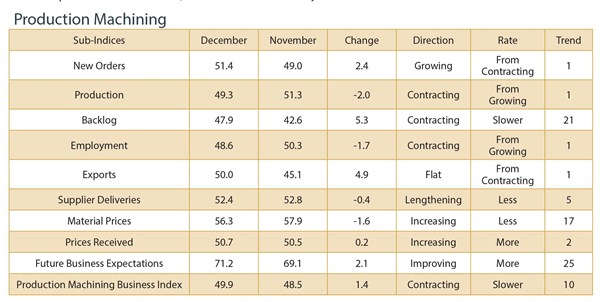Business Conditions Unchanged
But facilities with 20-249 employees saw improving business conditions in December.

With a reading of 49.9, Gardner’s precision machining index showed that business conditions were unchanged in December. While the index has not been above 50.0, which indicates growth, since June 2012, there has been significant improvement in the industry. Compared with 1 year ago, the index has been higher each of the last 3 months. And, in each of those 3 months, the month-over-month rate of change has showed that the rate of growth has accelerated. December’s index was 21.1 percent higher than it was 1 year ago.
New orders grew for the second time in 3 months. However, production contracted slightly after growing the two prior months. This was likely because the holidays fell during the middle of the week, causing plants to close for an extended period of time. Backlogs continue to contract, but at a much slower rate. This trend indicates that capacity utilization should improve significantly this year. Employment contracted in December after growing in November. Exports were flat in December, which ends the significant contraction of exports since the index began in December 2011. Supplier deliveries have lengthened at a consistent rate since the fall of 2012.
Material prices continue to increase, but the rate of increase has been trending down since January 2013. Prices received continue to increase at a modest rate. Future business expectations have increased substantially since last September, reaching their highest level since March 2012.
Facilities with 20-249 employees saw improving business conditions in December. However, conditions at the smallest facilities continue to contract. But the rate of contraction has been slower the last several months.
The South Atlantic region was the fastest growing region in December. It has grown 2 of the last 3 months. The Middle Atlantic region was the only other one to grow in December. It grew for the first time since February last year. Both the Pacific and West North Central regions contracted after growing in November.
Planned capital expenditures were at their second highest level since last February. The 1-month rate of change increased for the second month in row. And, the annual rate of change grew at a faster rate in December. This is a positive sign for capital equipment spending this year.


.JPG;width=70;height=70;mode=crop)
